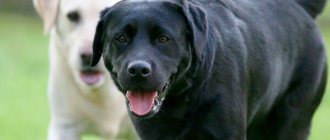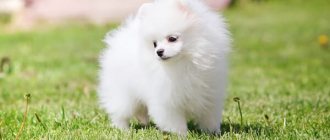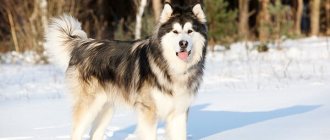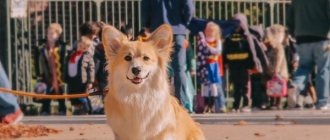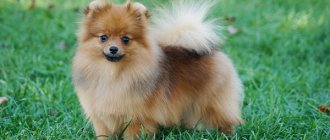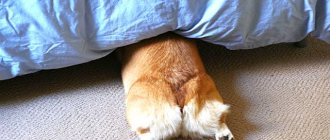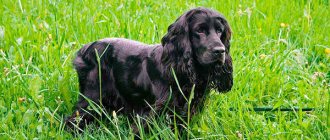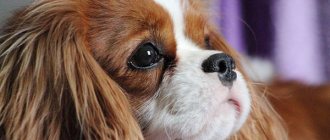Small representatives of Welsh Corgi dogs were brought by the Celts in the 10th century to Wales, which is still considered the birthplace of the breed.
They were originally used as herding dogs.
The official date of appearance (or, rather, registration) of this breed is 1892.
Since then, corgis have been actively gaining popularity all over the world. This is facilitated by the cute appearance of the teddy bear and cheerful, kind disposition.
Fluffy - defect or breed?
It so happens that the Fluffy Welsh Corgi is considered a breeding match. This is justified by the fact that in the genetic chain of such dogs there is a “fluffy” gene, which greatly changes the structure of the coat.
NOTE!
The road to exhibitions and competitions is closed for these kids; such dogs are not allowed to be bred, they are culled from the litter.
Basic colors (examples with photographs)
Prembrokes and Cardigans differ somewhat in the spectrum of colors, however, there are general rules of the standard for both types: only a black nose, dark eye color and strictly regulated limits of white color distribution.
Tricolor
This type of color implies the presence of three coat colors, one of which will be the main one. It turns out that two more colors are added to the white markings.
One of the subtypes is the black-headed color, such individuals are almost black in color with brown and white markings.
Another common subtype of tricolor is a deep color, when the main color is bright red, black along the body, and white in the areas of the chest, neck and muzzle.
Ginger
The most popular shade for representatives of the breed. At the same time, the red color can vary from pale red to bright shades in addition to a black “mask” on the muzzle, which gives a special charm to the doggies.
Sable
The sable color of the corgi looks truly rich, it gives the impression that the dog is glowing. The essence of the sable color is that the hair at the base is one color, and at the tips another.
Deer
Deer color refers to coat colors ranging from all shades of sandy-golden to very light tones. The highlight of this color will be the smooth transition from dark to light tones on the hips, under the tail, on the limbs and on the dog’s belly.
Grey
Gray Welsh Corgis are sometimes called Black Corgis. At birth, puppies are gray in color, but then it gradually fades and the dog’s back is covered with a dark gray or black-and-white color.
White
A completely white color is not inherent in the Welsh Corgi. The merle or blue merle color is considered a very beautiful phenomenon. With this color, the main coat of the Corgi is white-gray, white or gray with blue tones.
The secondary color range is represented by dark marks or spots.
brindle
Another type of Welsh Corgi color is brindle. It is represented by the presence of transverse stripes on the dog's body. The stripes are darker than the main color, often dark brown tones.
Registration of congenitally bob-tailed puppies
In 2004, in the breeding commission of the RKF, we approved a provision in which congenitally bob-tailed puppies in the pedigrees received the mark (k/x) if the pedigree was Russian and (n/b) in the international pedigree. I did not imagine then that such a mark would become a temptation for some corgi owners, who would be able to enter dogs with docked tails and such a mark in the pedigree for exhibitions in countries where the exhibition of docked dogs is prohibited.
The dog may have a short tail and be docked. And the display of docked dogs at international exhibitions in countries where docking is prohibited is not only a deception on the part of the owner of such a dog and the organizers of the exhibition, but also spoils the reputation of all Russian breeders. Unfortunately, such cases occur in Russian reality.
In our Kennel we do not dock puppies’ tails, so this problem does not exist for us. If a dog is born with a long bob, then such a tail will also be left and, I am sure, that such a puppy will find loving owners.
Until recently, I was in favor of not marking the pedigrees of dogs that were docked, this would eliminate the temptation to enter them into exhibitions in countries where docking is prohibited. But this is not entirely correct, because dogs participate not only in exhibitions, but also in breeding. In the absence of a note about congenital bobtail in the pedigree, it is quite realistic to assume that information about this may be lost. There had to be some way out of this situation, and it was found. At the forum of Pembroke owners, an option was proposed where a docking mark would be added to the mark on congenital bobtail in dogs with docked tails. In a Russian pedigree it would be (k/x) docked, and in an international pedigree (n/b) docked.
Such a formulation could well be approved in the RKF.
How do they appear?
"Fluffy" is a "coat gene" that makes dramatic changes to a dog's coat.
The first signs of “increased shaggyness” in a corgi appear by the age of one month - a little more puppy fluff appears on the puppy’s paws than the rest.
It is almost impossible to recognize fluffy at earlier stages of life. However, it is possible to predict the appearance of such corgis - it is enough to know that both the mother and father of the puppies are carriers of this hidden gene.
Origin story
The Welsh Corgi breed is considered one of the most ancient herding dogs; its homeland is Great Britain . There is a legend according to which corgis were sled dogs for elves who sympathized with the kind, but very poor peasant.
To help this man somehow improve his affairs, the elves presented him with two cute, hard-working dogs with short legs. This is how Welsh Corgis came to the human world for the first time.
As for fluffies, they began to appear when they tried to cross elf sled dogs with long-haired collies and shelties. This fact, however, does not have any documentary evidence, so today another version of the appearance of fluffy has the right to exist - a number of experts believe that a mutation, a divergence of genes, is to blame.
How to avoid appearance?
Typically, breeders carefully track the pedigree of potential litter parents. It is important to pay attention to the presence of at least one, even a distant relative, in whom this gene manifested itself. Such dogs are no longer allowed for breeding.
However, no breeder is immune from this “wool surprise”.
Description of the variety
In fact, fluffies do not reveal their interesting variety . They, like other corgis, have large erect ears, a long muzzle, and short but strong paws. The body is elongated and strong. Charming dark eyes set far apart.
It takes on the color from its parents. Most often these are classic “Corgivian” colors.
Fluffiches have long fur, so they need to be combed very often, their bellies washed after each walk, and their “fur coat” cleaned of leaves/sticks/snow.
Character traits
Despite the “cuteness” that corgis radiate, we must not forget that this breed is a distant relative of shepherd dogs . They can show good protective qualities or try to protect their owner even in those moments when this is not required.
Otherwise, representatives of this breed are kind-hearted creatures who adore children. All breeders unanimously say that corgis make excellent contact with children.
The breed is characterized by cheerfulness and energy, and in contrast, they always follow the owner’s commands.
Advantages
Cardigan and Pembroke dogs are people-oriented, love children and socialization. But even the advantages of the species have some differences:
- The best owners of Pembrokes will be a family that leads an active lifestyle. They love walks, physical activity, and games.
- If, when training Pembrokes, everything is done in a playful way, then the baby will very quickly master any commands.
- Pembrokes always show their emotions, show love and friendliness.
- Pembrokes are always curious, while Cardigans prefer to be close to their owner.
- Cardigans can control themselves and sense the mood of the owner.
- Cardigans love to work and are easier to train. They are suitable even for novice dog owners.
Advantages and disadvantages
The advantage of the breed is its very powerful skeleton. Due to their small stature and strong muscles, the dogs are very hardy and strong.
They are easy to train. They obey their owner unquestioningly and master commands on the fly.
This breed is perfect for living in an apartment due to its size, which can also be considered a positive thing.
IMPORTANT!
The downside of fluffy is the complete absence of undercoat.
“Classic” corgis have a rather dense undercoat. Fluffies' fur gets wet very quickly in any rain; in winter, lumps of snow stick to the dog, and in summer, twigs and leaves get tangled in it.
Also, a dog’s hyper-attachment can also be a big inconvenience for the breeder. She falls in love with her owner and experiences great stress during any, even short, separation.
Dog nicknames: names for Welsh Corgis
Names for boys Welsh Corgi
- HAGGEI (from other Hebrew “festive”, “merry”). By nature, the dog should be kind, fast, and personable.
- AMETHYST. The nickname is given in honor of a beautiful gemstone. The dog has a proud character and is very attached to its owner. Change of owner is difficult to bear.
- BARSIK. This is a small domestic dog. They have a kind, calm disposition and love children very much.
- BIM. The nickname is borrowed from the film by G. Troepolsky “White Bim Black Ear.” The dog's name itself is kind. Dogs are highly trainable; They love children, are not malicious, they love their owners very much, they are devoted to them. Very smart. They don't leave their home.
- HAROLD (from other Germanic “army” and “to command”). The dog has a complex character. She is stubborn, proud, courageous, self-confident, and efficient.
- GASTON (from other Germanic “guest”, “foreigner”). The man's name became the dog's name. This nickname is given to large and small purebred dogs of noble origin.
- GIDEON (from other Hebrew “slasher”, “to chop”). This nickname is given to a brave, strong dog.
- GORDON (from a Scottish surname). The nickname is not new, but it is rare. These are strong dogs with an excellent sense of smell and are easy to train. This nickname can only be given to purebred dogs.
- JARED, JARED (from Latin, Greek, other Hebrew “descended”). This is a calm dog.
- JASON (from other Greek “healer”). Dogs with this nickname are completely gentle, the kindest domestic creatures.
- JOHN (from other Hebrew “John”, “god bestowed”, “given by God”). In the Bible the name of the baptist and apostle. This nickname can only be given to purebred medium-sized dogs. They have a good disposition. Winter ones are stronger than summer ones. Dogs are touchy, so it’s best not to let them off the leash. These dogs love their mistress more than their owner.
- JULBARS. This is a strong, brave, angry dog that obeys only its owner. Patient with pain. Kind to those who care for her.
- DOMINIK, DOMENIK (from Latin “dominant”). This beautiful nickname is for medium-sized dogs, exclusively purebred.
- BUG, BUG. A small, fluffy, capable dog. Strong and brave. He is easy to train and can work as a circus performer.
- ICARUS (from Latin, Greek, “dedicated to the Moon”). In Greek mythology, Icarus, the son of Daedalus, escaped from captivity on the island of Crete, flying away on wings made from feathers and wax by his father. This is a beautiful name for a dog. This is a kind dog, easy to train, recognizes only its owner, is very efficient, and a good watchman.
- CALVIN. Puppies are often given this nickname for their beauty. Nickname for purebred medium-sized dogs.
- QUINT (from Latin “fifth”). This nickname is given to purebred dogs with a calm disposition. You need to be strict when dealing with them. These are kind, efficient dogs that are easy to train, but do not like cruel treatment.
- KARL (from other Germanic “courageous”, “man” and “man”). These are usually small dogs that can be trained.
- CLARK. The nickname comes from the surname. This is a small domestic dog, strict, when meeting loved ones, it always barks when greeting the owner, as if saying hello!
- CLAUDE (French version of the name Claudius from the Latin “lame”). This is a nickname for dogs that are small, kind, loving children, and well trained.
- KIN. Translated from the language of the inhabitants of the Isle of Man (in the Irish Sea) it literally means “warrior”. The dog is kind and affectionate in nature; good athlete.
- MILAN (city in Italy). These are large, kind domestic dogs, loving children, warm-hearted and calm.
- MICAH (an abbreviation of the other Hebrew name “like the god Yahweh”). The nickname is given to a gentle, affectionate creature, devoted to its owner.
- MORGAN (“great”, “light”, “bright”). This nickname should be given to a calm dog who loves people.
- NOUA (“peace”, “calm”). This nickname should be given to phlegmatic dogs, small ones and only domestic ones. These dogs have a calming effect on humans.
- ORESTES (from Greek, “mountain”). This is a large, calm dog, very attached to its owner, although it does not tolerate changes in ownership too painfully.
- OSCAR (from other herm, “god” and “spear”). The character of such dogs is complex. These are smart, proud dogs who love children and do not offend anyone.
- FLUFF. A small fluffy dog that is easy to train. These kind dogs warmly welcome members of the owner's family. They love to play with children.
- GLAD. The nickname comes from the word “rejoice.” It can be given to any dog. These strong, hardy dogs are kind, but they love to scare people with their roars. Nickname for purebred dogs.
- TEMOTHY, TIMOTHY (from the Greek “honoring”). These are dogs with an impulsive temperament, hardy, hardworking, but not leaders.
- TIFFANY (derivative of another Greek “god shows”, Russian Feofan). A dog with a calm, kind disposition. Somewhat phlegmatic. Loves children.
Best articles: Description, habitat, nutrition, species, photos and videos of the jaguar
Photos of colors
The color of dogs is varied. It can be a solid color (any color) with white spots. Can be black, sandy, red (red), black and tan.
The classic “tricolor” is also often found - light red, black and white.
Often the Corgi's legs and chest are white.
Maintenance and care
The first thing to remember when buying a Corgi (it doesn’t matter: Pembroke, Cardigan or Fluffy) is that dogs are extremely active . Clumsy at first glance, they display agility by jumping and running while walking. Therefore, you will have to walk a lot. You can't get away with a half-hour evening promenade here.
Teeth brushing and nail trimming are just as important for babies as they are for other dogs. These procedures should not be neglected.
NOTE!
You will have to tinker with the wool. Taking into account its fluffiness and length, your pet will have to be combed often. After each walk, you need to pull out branches and leaves, and in winter, clean out the snow.
As mentioned above, fluffies have no undercoat. Even if there is light drizzle and wind outside, the walk will have to be limited in time, because... the animal will get wet and freeze very quickly, even if it moves constantly.
Nurseries
It is not recommended to buy a puppy secondhand or through advertisements from people with an unverified reputation. To purchase a puppy, it is better to contact professional nurseries. A decent breeder will tell you straight out that Fluffy is not a dog for exhibition, but a pet for the soul. If the seller starts talking about how the long-haired corgi is the newest type of breed, it is better to run away from there as quickly as possible. Most likely, the owner of the puppies is trying to mislead potential buyers.
In any Welsh Corgi nursery you can find fluffy puppies, since the risk of such non-standard babies is always high.
Breed:
- Nursery “Talisman Vasilisa”, Rostov region, Taganrog, www.lisatalisman.com
- Nursery “Zelveger” St. Petersburg, zelveger.ucoz.ru
How to walk correctly?
With such an active dog, any walk should be accompanied by games of ball, tag, “flying saucers” and other activities. Evening walks should be especially full of movement so that the little dog’s energy is depleted and he sleeps peacefully at night.
Of course, it is necessary to ensure that flaffies do not take anything from the ground. You should not let them rummage through heaps of autumn leaves, because, in addition to the health hazard, this will cause inconvenience to the owner, because all this foliage, along with the dog’s fur, will come into the house.
Life expectancy and health
Corgis live quite a long time. On average, life expectancy is about 10 years.
Despite their endurance, these dogs are prone to colds (due to the fact that fluffy has no undercoat). Therefore, it is very easy to get pneumonia or other diseases based on a cold.
In addition to colds, the Corgi breed itself is often carriers of chronic diseases, such as:
- Cataract . An eye disease when bright light blinds the pet and prevents it from seeing normally. This happens due to clouding of the main part of the eye - the “lens”.
- Epilepsy . Yes, some babies suffer from this terrible disease. Manifests itself in the form of seizures.
- Hip dysplasia Closer to old age, this becomes especially noticeable, because... The dog begins to limp constantly. The owner needs to closely monitor his dog with this disease, because... A dog can sprain its paw at any time.
- Behavioral disorders . Sometimes it happens that the dog begins to aggressively attack the owner and family members. Or, on the contrary, he begins to be afraid of everyone and hides.
- Narcolepsy . The dog just suddenly falls asleep. Walked and fell asleep. I ate and fell asleep. An extremely dangerous disease, if you imagine how it can turn out.
- Bleeding disorders are common in Corgis.
- Thyroid problems.
Owner reviews
Tamara L.: “Out of the entire litter of corgis, I immediately had my eye on the fluffier baby than the rest. It was love at first sight. Mickey has been in our family for a year and a half now. Wonderful dog."
To read: Beagle breed features, puppy price and owner reviews
Arina F.: “I treat my fluffy as a miracle of nature - smart, loyal, with a sense of humor, a smiling face.”
Vika: “If you don’t think about exhibitions, you have to choose Fluffy from all the corgis (that’s what I did), the most charming puppy. A living toy!
Dimensions and weight
Fluffies completely replicate the appearance of standard Pembrokes and cardigans. The “marriage” of puppies is only revealed by their fur.
There are often cases when, under the guise of simple flaffies, they passed off not corgis at all, but mixed breeds of small breeds.
The table below provides a description of the breed (standards):
| Characteristics | Boys | Girls |
| Weight | 25-30 cm | 25-27 cm |
| Height | 10-12 kg | 8-11 kg |
| Torso | Squat, elongated | |
| Eyes | Set wide apart | |
| Paws | Short, strong | |
| Head | Resembles a fox, the skull is longer than the muzzle | |
| Wool | Long, fluffy on paws | |
Bull Terrier – Gladiator in a White Tailcoat
England is considered the birthplace of all rat-faced dogs. This breed was developed by James Hincks. Back in the 19th century, he introduced everyone to a white dog with an ordinary appearance. After some time, a fighting bull terrier of a different color appeared. Several completely different breeds took part in the selection:
- English bulldog;
- Dalmatian;
- white English terrier.
Bull Terrier dog
For many years it was believed that keeping a house of this breed was a sign of good taste. The rat-like dog was a huge success among almost all dog breeders in England. The breed standards are as follows:
- muscular torso;
- height up to 55 cm;
- weight up to 30 kg;
- long elongated head with a shark mouth;
- powerful jaws;
- small tail;
- a big nose.
The color can be varied, but most attention is paid to white wool. A dog with a muzzle like a rat, despite its muscular build, has sufficient agility and can jump high
Head structure
Almost immediately, a dog with a rat's face catches the eye due to the unusual egg-shaped head. Many people find her attractive. The features are as follows:
- the muzzle immediately catches the eye due to the powerful jaw, the teeth are very strong;
- the head is set low on a muscular and strong neck;
- The ears are triangular and erect. They are located quite close to each other;
- the nose is large. Many people argue that a dog with a long nose resembles a rat and is therefore unattractive;
- The eyes are very small and set wide apart, which is why many people think that the dog looks like a pig.
Top articles : Bernese Mountain Dog: the loyal giant
Note! A pit bull with a sharp muzzle is not an elegant dog. The dog's habits look unusual due to its massive body and interesting face.
Coat and colors
Pit bull terriers or pit bulls must be white in color according to the standards. Skin pigmentation largely determines a dog's attractiveness. In addition, wool can be of other shades:
- red color without any markings. In this case, shades can differ significantly, even dark brown;
- black color is less common than others;
- Two-color bull terriers differ from others in that they have large areas of contrasting color. There are a variety of combinations, for example, black and red. White patches spread over the face, paws or chest. Ideally, they should account for no more than 50% of the color;
- There is also a three-color color variant. It is represented by a combination of black, red and white. In most cases, a black tint predominates; white should be no more than 50%. The red color accounts for the least, it appears on the muzzle or chest, as well as on the limbs.
- brindles were not immediately recognized, but eventually they began to be considered at exhibitions. The color of such a dog is represented by a combination of red and dark stripes. In some cases there are white markings.
The coat is thick and short, so a dog with a large nose is also suitable for keeping in an apartment. The pet does not require careful care.
Important! Almost all dog breeders claim that blue color is absolutely unacceptable and such individuals should not be bred
How to feed?
Corgis are not hyper-allergic dogs. However, experienced breeders and veterinarians advise feeding these dogs with ready-made dry food, citing its balance. In addition, natural nutrition for corgis is necessarily accompanied by the addition of various vitamins to the food.
Corgi babies are fed 5-6 times a day. Gradually increasing portions and decreasing the frequency of feeding, by the age of 8 months, feeding the dog is reduced to twice a day. The food bowl must be set out strictly according to the clock so that the dog is trained to eat only at this time, and not when the whole family gathers at the table for dinner.
Again, despite the fact that dogs are not susceptible to allergies, there are prohibited foods when feeding them naturally:
- Potato.
- Citruses.
- Fermented milk products (with the exception of low-fat cottage cheese).
- Milk.
- Pork.
- Mutton.
- Bones.
- Raw fish
- Oatmeal.
- Pearl barley.
- Legumes (peas, corn, beans).
How to choose the right puppy?
The first thing you should pay attention to is the price. Fluffy should not cost very little, because... This is, after all, a corgi.
The second point is wool. Before the show, it’s better to search the Internet for pictures that show Cardigan and Fluffy Welsh Corgis. Please note that the latter have slightly longer fur. This will also help if a potential breeder is offered a fluffy under the guise of a standard corgi.
And lastly, the buyer must like the dog and show interest in the guest. If the puppy does not show much activity, then you should ask the breeder about the reason for the passivity. Perhaps the puppy has just eaten, but it won’t hurt to be on the safe side.
Features of junior molt
The junior moulting period begins at approximately one year of age (at 10-15 months of age). In a one-year-old dog, literally kilograms of fluff are combed out; guard hairs come out especially strongly on the sides and collar. At this time, it is advisable to visit a groomer, wash the animal, and “blow out” excess hair.
Junior molt is the most abundant, but it occurs in different ways. Some corgis become “bald” for several months - you can’t look at them without tears; in others, the hair simply comes out in clumps, but quickly grows back. Some owners get scared and start giving the dog all kinds of vitamins and dietary supplements, but veterinarians think that this is unnecessary. After a complete change of the “baby” fur, a new one grows - long, thick.
